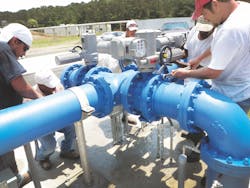One of the most cost-effective storage methods for large volumes of water utilizes aquifers or water-bearing formations, usually with virtually limitless storage capacity. Aquifer storage recovery (ASR) does not provide a new source of water, but is a water storage technology that helps manage existing water resources, enhancing their yield and reliability at relatively low cost.
Large Storage Volumes
ASR is a powerful technology for water storage, water resources management and environmental protection, enabling water storage underground through a well when excess water is available, or when recharge water quality is best, for recovery from the same well when needed to meet water utility, agricultural, ecosystem, industrial, recreational, emergency and several other water uses. It can be used for storage of potable water, reclaimed water, surface water, storm water and groundwater from other aquifers, and as a component in thermal systems. The pretreatment requirements for water stored utilizing ASR depend on the quality of the native water within the storage zone(s), the aquifer lithology and geochemical characteristics, plus state and federal regulatory requirements.
Water is stored deep underground in aquifers that may be in sand, clayey sand, sandstone, gravel, limestone, dolomite, glacial drift, basalt, fractured bedrock and other types of geologic settings. ASR well depths range from 170 to 2,900 ft. Stored water displaces the water naturally present in the aquifer, creating a very large bubble around the well, part of which is intended for recovery; the remainder is a permanent buffer zone that is not recovered, separating the stored water from the surrounding native groundwater. The bubble usually is confined by overlying and underlying geologic formations that produce little or no water; however, at several sites the aquifer may also be unconfined or semi-confined. Storage volumes in these bubbles range from as small as about 13 million gal in individual ASR wells, to as much as 2.5 billion gal or more in large ASR well fields.
The storage zones utilized for ASR include fresh water, brackish water and saline water aquifers. Most fresh water aquifers have one or more constituents in the native groundwater that are not wanted in the water to be recovered from ASR wells. Typical constituents may include iron, manganese, hydrogen sulfide, fluoride or arsenic. Operating experience at more than 200 ASR wellfields in the U.S. has demonstrated the viability of design and operational measures to ensure that recovered water from these wells meets applicable water quality standards.
A typical ASR system utilizes the same wells for both recharge and recovery. Water stored underground is safe from losses due to evaporation, transpiration, seepage, siltation or contamination. Lateral movement of the stored water bubble usually is very slow, particularly in deeper, confined aquifers, so that for most ASR applications the recovery efficiency is close to 100%. For potable water ASR, finished water can be readily recovered and introduced into the utility’s water distribution system. Retreatment of the recovered potable water is not required other than to restore the chlorine residual to maintain disinfection within the distribution system.
When ASR is utilized for seasonal storage, water treatment plants used in conjunction with it can be designed to treat closer to average flows rather than peak flows. The water treatment plant can run at capacity year-round, storing excess water within the well. The ASR system then can seasonally provide supplemental water as required to meet peak system demands. The result can be a tremendous capital cost savings for smaller water treatment facilities and can result in simpler, constant rate operation of those facilities. When compared with alternatives for potable systems requiring construction of water treatment plants, long transmission pipelines, pumping stations and surface reservoirs to meet increasing peak demands, potential savings typically exceed 50% and have been known to exceed 90%. ASR is most cost-effective when aligned with existing or new water sources.
A second important driving force has been the increased recognition of this technology as being sustainable, good for the environment, and useful for preservation of aquatic and terrestrial ecosystems. By reducing or eliminating the need for dam construction, and by providing reliable water supplies through diversions of flood flows instead of low flows, ASR systems contribute to water system sustainability and are environmentally friendly.
Typical ASR Applications
Most ASR systems provide seasonal water storage, storing water during the wet season and recovering it during the following dry season. Many also use ASR for water banking, storing water during wet years and recovering it years later during extended droughts, and for a number of other uses. Increasingly, many water managers are constructing ASR systems to ensure reliability during emergencies, whether severe floods, earthquakes, contamination incidents, pipeline breaks, or potential damage due to warfare or sabotage. At least 27 ASR applications have been identified, and others will undoubtedly follow as end users recognize other problems that can be mitigated using their ASR systems.
Some of the more common uses of ASR technology include:
- Seasonal storage for potable water systems. Recharge of excess available water during low demand periods for recovery to meet seasonal peak demands.
- Long-term storage. Recharge of excess available water (“water banking”) for longer-term storage for recovery during droughts and when other sources are not available.
- Emergency storage. Storage of excess available water (“strategic water reserve”) for use in case of potential catastrophic events such as floods, terrorist attacks or war.
- Diurnal storage. Short-term storage of water to meet daily peak system demands in parts of the distribution system that may have inadequate pipe sizes or other limitations, and to help maintain distribution system pressures and flows.
- Disinfection byproduct reduction. Storage of potable water underground usually results in the reduction of disinfection byproducts. Also, blending of recovered water when surface water sources experience seasonal precursor peaks can reduce overall disinfection byproduct levels.
- Storage of reclaimed water or excess surface water for reuse. Reclaimed water or excess surface water with pretreatment can be stored for seasonal use within a water reuse system, or for aquifer recharge.
- Groundwater level restoration. Recharge of aquifers can restore groundwater levels and control surface subsidence.
- Agricultural water supply. Excess water with appropriate pretreatment such as bank filtration can be stored to enhance the seasonal irrigation water supply for agricultural uses.
- Aquifer thermal energy storage. Chilled or heated water can be stored for seasonal use in HVAC systems or for various processes.
Cost of ASR
More than 500 ASR wells currently are operational in at least 22 states in the U.S. Many more ASR wells and wellfields are operating in other countries. The driving force behind the current rapid implementation of ASR technology is water supply economics. ASR systems usually can meet water management needs at less than half the capital cost of other water supply alternatives. As a result of the very large storage capacity of an ASR system, the capital cost to implement ASR on a gallon-per-day capacity is on the low end of the spectrum.
Typical Seasonal Potable Water System
Currently, the most common use of ASR is for seasonal storage of potable water. The Hilton Head Public Services District (HHPSD) on Hilton Head Island, S.C., utilizes three sources of water for their potable system:
1. Groundwater directly from the Upper Floridan Aquifer at depths of about 100 to 200 ft;
2. Purchased water originating from the Savannah River and treated by the Beaufort Jasper Water & Sewer Authority (BJWSA); and
3. Water from HHPSD’s reverse osmosis water treatment plant (RO WTP), which utilizes brackish groundwater from the Middle Floridan Aquifer (MFA). Surplus water from BJWSA is seasonally available for purchase by HHPSD at a discounted rate; therefore, HHPSD required a large seasonal storage system in order to take advantage of the discounted pricing when BJWSA has additional capacity, and to allow HHPSD to operate their RO WTP at its optimum capacity.
The ASR system consisted of a new aquifer storage recovery well completed into the MFA, vertical turbine pump, wellhead piping, a building that housed the chemical feed system used to restore the chloramine residual to recovered water, electrical equipment and I&C/SCADA system for the facility. The total construction cost was approximately $1.092 million, and the project was completed in 23 months from start to finish. The rated recovery capacity of the ASR system is 2.16 million gal per day; therefore, the capital construction cost of the system was $0.51 per gal per day recovery capacity. The ASR system provides seasonal storage and recovery of 240 million gal. A similar investment of $1.1 million for the construction of a conventional pre-stressed concrete storage tank would provide less than 2 million gal of storage.
For HHPSD, the ASR system provides underground storage for large volumes of potable water much more cost-effectively and with a smaller surface footprint than surface storage facilities.
Download: Here


